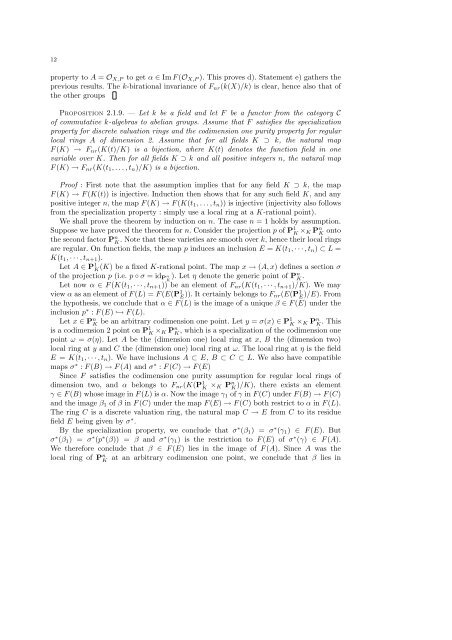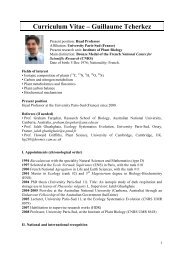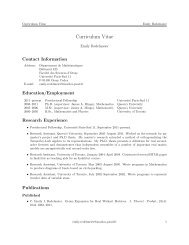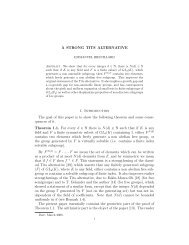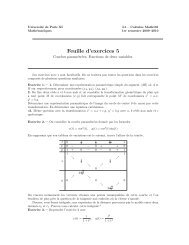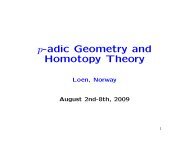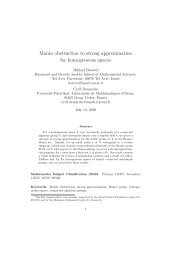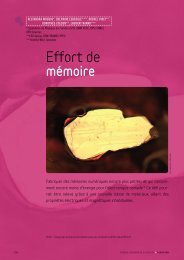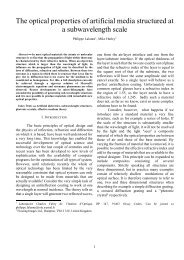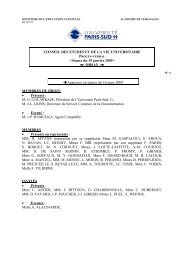Birational invariants, purity and the Gersten conjecture Lectures at ...
Birational invariants, purity and the Gersten conjecture Lectures at ...
Birational invariants, purity and the Gersten conjecture Lectures at ...
Create successful ePaper yourself
Turn your PDF publications into a flip-book with our unique Google optimized e-Paper software.
12<br />
property to A = O X,P to get α ∈ Im F (O X,P ). This proves d). St<strong>at</strong>ement e) ga<strong>the</strong>rs <strong>the</strong><br />
previous results. The k-bir<strong>at</strong>ional invariance of F nr (k(X)/k) is clear, hence also th<strong>at</strong> of<br />
<strong>the</strong> o<strong>the</strong>r groups<br />
PROPOSITION 2.1.9. — Let k be a field <strong>and</strong> let F be a functor from <strong>the</strong> c<strong>at</strong>egory C<br />
of commut<strong>at</strong>ive k-algebras to abelian groups. Assume th<strong>at</strong> F s<strong>at</strong>isfies <strong>the</strong> specializ<strong>at</strong>ion<br />
property for discrete valu<strong>at</strong>ion rings <strong>and</strong> <strong>the</strong> codimension one <strong>purity</strong> property for regular<br />
local rings A of dimension 2. Assume th<strong>at</strong> for all fields K ⊃ k, <strong>the</strong> n<strong>at</strong>ural map<br />
F (K) → F nr (K(t)/K) is a bijection, where K(t) denotes <strong>the</strong> function field in one<br />
variable over K. Then for all fields K ⊃ k <strong>and</strong> all positive integers n, <strong>the</strong> n<strong>at</strong>ural map<br />
F (K) → F nr (K(t 1 , . . . , t n )/K) is a bijection.<br />
Proof : First note th<strong>at</strong> <strong>the</strong> assumption implies th<strong>at</strong> for any field K ⊃ k, <strong>the</strong> map<br />
F (K) → F (K(t)) is injective. Induction <strong>the</strong>n shows th<strong>at</strong> for any such field K, <strong>and</strong> any<br />
positive integer n, <strong>the</strong> map F (K) → F (K(t 1 , . . . , t n )) is injective (injectivity also follows<br />
from <strong>the</strong> specializ<strong>at</strong>ion property : simply use a local ring <strong>at</strong> a K-r<strong>at</strong>ional point).<br />
We shall prove <strong>the</strong> <strong>the</strong>orem by induction on n. The case n = 1 holds by assumption.<br />
Suppose we have proved <strong>the</strong> <strong>the</strong>orem for n. Consider <strong>the</strong> projection p of P 1 K × K P n K onto<br />
<strong>the</strong> second factor P n K . Note th<strong>at</strong> <strong>the</strong>se varieties are smooth over k, hence <strong>the</strong>ir local rings<br />
are regular. On function fields, <strong>the</strong> map p induces an inclusion E = K(t 1 , · · · , t n ) ⊂ L =<br />
K(t 1 , · · · , t n+1 ).<br />
Let A ∈ P 1 K (K) be a fixed K-r<strong>at</strong>ional point. The map x → (A, x) defines a section σ<br />
of <strong>the</strong> projection p (i.e. p ◦ σ = id P<br />
n ). Let η denote <strong>the</strong> generic point of Pn<br />
K K .<br />
Let now α ∈ F (K(t 1 , · · · , t n+1 )) be an element of F nr (K(t 1 , · · · , t n+1 )/K). We may<br />
view α as an element of F (L) = F (E(P 1 E )). It certainly belongs to F nr(E(P 1 E )/E). From<br />
<strong>the</strong> hypo<strong>the</strong>sis, we conclude th<strong>at</strong> α ∈ F (L) is <strong>the</strong> image of a unique β ∈ F (E) under <strong>the</strong><br />
inclusion p ∗ : F (E) ↩→ F (L).<br />
Let x ∈ P n K be an arbitrary codimension one point. Let y = σ(x) ∈ P1 K × K P n K . This<br />
is a codimension 2 point on P 1 K × K P n K , which is a specializ<strong>at</strong>ion of <strong>the</strong> codimension one<br />
point ω = σ(η). Let A be <strong>the</strong> (dimension one) local ring <strong>at</strong> x, B <strong>the</strong> (dimension two)<br />
local ring <strong>at</strong> y <strong>and</strong> C <strong>the</strong> (dimension one) local ring <strong>at</strong> ω. The local ring <strong>at</strong> η is <strong>the</strong> field<br />
E = K(t 1 , · · · , t n ). We have inclusions A ⊂ E, B ⊂ C ⊂ L. We also have comp<strong>at</strong>ible<br />
maps σ ∗ : F (B) → F (A) <strong>and</strong> σ ∗ : F (C) → F (E)<br />
Since F s<strong>at</strong>isfies <strong>the</strong> codimension one <strong>purity</strong> assumption for regular local rings of<br />
dimension two, <strong>and</strong> α belongs to F nr (K(P 1 K × K P n K )/K), <strong>the</strong>re exists an element<br />
γ ∈ F (B) whose image in F (L) is α. Now <strong>the</strong> image γ 1 of γ in F (C) under F (B) → F (C)<br />
<strong>and</strong> <strong>the</strong> image β 1 of β in F (C) under <strong>the</strong> map F (E) → F (C) both restrict to α in F (L).<br />
The ring C is a discrete valu<strong>at</strong>ion ring, <strong>the</strong> n<strong>at</strong>ural map C → E from C to its residue<br />
field E being given by σ ∗ .<br />
By <strong>the</strong> specializ<strong>at</strong>ion property, we conclude th<strong>at</strong> σ ∗ (β 1 ) = σ ∗ (γ 1 ) ∈ F (E). But<br />
σ ∗ (β 1 ) = σ ∗ (p ∗ (β)) = β <strong>and</strong> σ ∗ (γ 1 ) is <strong>the</strong> restriction to F (E) of σ ∗ (γ) ∈ F (A).<br />
We <strong>the</strong>refore conclude th<strong>at</strong> β ∈ F (E) lies in <strong>the</strong> image of F (A). Since A was <strong>the</strong><br />
local ring of P n K <strong>at</strong> an arbitrary codimension one point, we conclude th<strong>at</strong> β lies in


